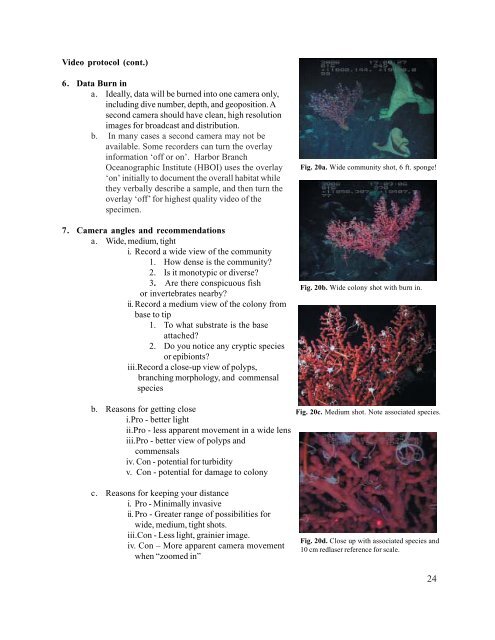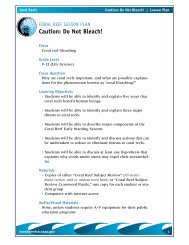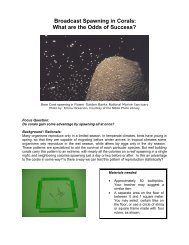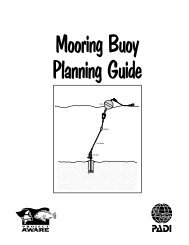Documenting deep-sea coral collectionsIn situ video and photography is often available to modern deep-sea explorations. Most submersiblesand ROVs are equipped with 3 chip digital video cameras and high resolution still cameras. Video andphotography are particularly useful for sharing information between scientists, for tentative speciesidentifications, and for public outreach efforts. Video documentation has the additional benefit ofrecording community structure, e.g. target species density along a transect, and associated commensalspecies. Still photo documentation is most useful for tentative species identifications and for publications.High quality images can depend on several things. The most important are proper exposure, and properresolution. Too much light (often from a flash) can result in over-exposure. Too little light will result inunderexposure, and a grainy image with poor detail. Angle the lights 45 degrees downward to avoidbackscatter from plankton. Try and use your available light judiciously, and get as close as possible toyour subject. Still image captures from video are limited to the scan resolution of the video and thesoftware. Some video captures are very low resolution, e.g. 72 dpi. This is suitable for internetdistribution. Print quality (300 dpi) in situ images may require a still camera, or a “still photo” setting onthe DV Camera.Sseparate video and photo protocols are provided. The video section will discuss camera, lights, andmedia format. The video section will also present some proven video transect methods and somerecommended camera angles. The photo section will discuss “life cycle” photo documentation so thatyour in-situ photo stills can be matched to dried specimens on deck, and to live polyps under themicroscope.Video protocol1. Camera Quality:a. 3 chip (CCD) video cameras are superior to one chip video cameras.b. Low light (SIM) cameras are grainy, and poor. HDTV cameras are the best available.2. Lights:a. Quality: All lights have a different color temperature, and the camera setting must match thattemperature using the white balance. Daylight is 5200 K, tungsten light is 3600 K.. Xenon lightsare approximately 4200 K.b. Quantity: 1000 watts of Xenon light are bestc. Position: Lights positioned behind armatures cause shadow, and/or underexposure because theyreflect light into the camera iris. Position lights high and to the side, angled downwards.3. Archival Media Quality:a. HD, DVCam, Digibeta, Beta SP, and Mini-DV are archival quality video tape formats.b. These are magnetic tape mediums, and will degrade within 10-15 years. 14. Archival digital resolution:a. Broadcast quality digital video (.mov, .mpg, .mp4) is 720 x 480 pixels5. Distribution digital resolution:a. Medium: 320 x 240 Compressed video is most suitable for internet distributionb. Small: 160 x 120 is commonly referred to as “postage stamp size”, very small.1Temperature and humidity are the most important factors to maintaining footage for extended time spans. If you planto start a collection, or have an aging one, consider dubbing tapes five to seven years old to a contemporary tapemedium, such as Beta SP, then to a digital medium, such as DVD. If you have ¾” Sony tapes older than ten years youmay wish to consult a restoration facility, such as SPECS Brothers in Ridgefield Park, NJ. www.specsbros.com23
Video protocol (cont.)6. Data Burn ina. Ideally, data will be burned into one camera only,including dive number, depth, and geoposition. Asecond camera should have clean, high resolutionimages for broadcast and distribution.b. In many cases a second camera may not beavailable. Some recorders can turn the overlayinformation ‘off or on’. Harbor BranchOceanographic Institute (HBOI) uses the overlay‘on’ initially to document the overall habitat whilethey verbally describe a sample, and then turn theoverlay ‘off’ for highest quality video of thespecimen.7. Camera angles and recommendationsa. Wide, medium, tighti. Record a wide view of the community1. How dense is the community?2. Is it monotypic or diverse?3. Are there conspicuous fishor invertebrates nearby?ii. Record a medium view of the colony frombase to tip1. To what substrate is the baseattached?2. Do you notice any cryptic speciesor epibionts?iii.Record a close-up view of polyps,branching morphology, and commensalspeciesFig. 20a. Wide community shot, 6 ft. sponge!Fig. 20b. Wide colony shot with burn in.b. Reasons for getting closei.Pro - better lightii.Pro - less apparent movement in a wide lensiii.Pro - better view of polyps andcommensalsiv. Con - potential for turbidityv. Con - potential for damage to colonyFig. 20c. Medium shot. Note associated species.c. Reasons for keeping your distancei. Pro - Minimally invasiveii. Pro - Greater range of possibilities forwide, medium, tight shots.iii.Con - Less light, grainier image.iv. Con – More apparent camera movementwhen “zoomed in”Fig. 20d. Close up with associated species and10 cm redlaser reference for scale.24
















